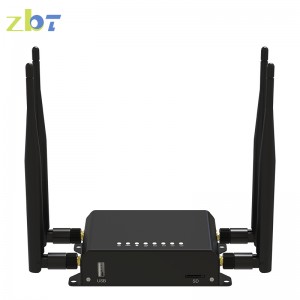Products
ZBT WE826-T2 4G LTE 10GB ESIM Data Single Bands 300Mbps 2.4G Wireless Router With MTK7620A Chipset
First, Global 4G Bands 4G module installed
LTE FDD: B1/B2/B3/B4/B5/B7/B8/B9/B12 /B13/B17/B18/B19/B20/B25/B26/B28/B66
LTETDD:B34/B38/B39/B40/B41
WCDMA/HSPA: B1/B2/B4/B5/B8
GSM/GPRS/EDGE: B2/B3/B5/B8
Second, 10Gb eSIM data for your first usage
When you run out this eSIM data, if you think it is good, you can recharge it. And if you sell this products to your clients, everytime they recharge, you will get commission.


ZBT WE826-T2 is a 4G LTE single-band 300Mbps 2.4GHz wireless router supporting 10GB ESIM data, using MTK7620A chipset.
The router has 4 Gigabit Ethernet ports and a USB 2.0 interface, which can connect multiple devices at the same time, and supports remote management, multiple SSID, QoS and other functions.
In addition, WE826-T2 also provides a secure VPN function to meet the needs of small offices and home networks.

● Support 802.11N/802.11G/802.11B network protocol, the max transmission rate could be 2.4G 300Mbps
● Support 802.11.3/802.3U protocol, 5* 10/100M bps Auto MDI/MDIX
● 1 USB 2.0 date interface
● 1 Micro SD Card Slot
● Support 3G/4G
● Many kinds of encryptions to protect your data transmission;

| Hardware | |
|
Main Chipset |
MT7620A |
|
RAM |
DDR2 128MB (MAX DDR2 256MB) |
|
SPI FLASH |
16MB (MAX 32MB) |
|
Protocol |
IEEE 802.11n, IEEE 802.11g, IEEE 802.11b, IEEE802.11ac, IEEE802.11a, IEEE 802.3, IEEE 802.3u |
|
RT Power |
802.11b 18dBm±2dBm;802.11g 15dBm±2dBm;802.11n 15dBm±2dBm; |
|
Reception Sensitivity |
802.11b: -83dBm@10% PER802.11g: -74dBm@10% PER802.11n: -68dBm@10% PER |
|
Work Channel |
2.4GHz choose: 1-13 |
|
Wireless Rate |
Max. 300Mbps |
|
Work Frequency |
2.4GHz |
|
Antenna |
2* 5dBi antenna or 4*5dbi external antenna (With 3G/4G) |
|
Interface |
1*PCI-E slot1*SIM card slot1*USB 2.0 port
1*Micro SD card slot 1*10/100/100M WAN port (Auto MDI/MDIX) |
|
LED |
Power, USB, 2.4G, WAN, LAN1, LAN2, LAN3, LAN4 |
|
Button |
Reset |
|
Max Power consumption |
< 12W |
| Others | |
|
Work Environments |
Operating Temperature:0℃ ~ 40℃; Storage Temperature:-40℃~ 70℃;Operating Humidity:10%~90% non-condensing Storage Humidity:10%~90% non-condensing |
|
Adapter |
12V 1A |
|
Authentication |
CE, FCC, RoHs |
|
Other accessories |
Power adapter, Ethernet cable |

Skype: zbt12@zbt-china.com
Whatsapp/phone: +8618039869240











